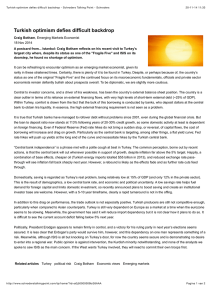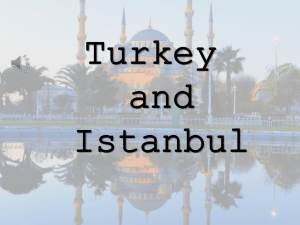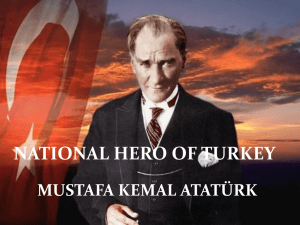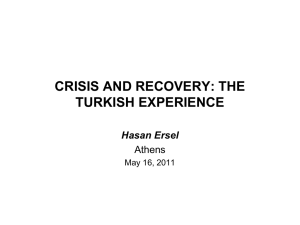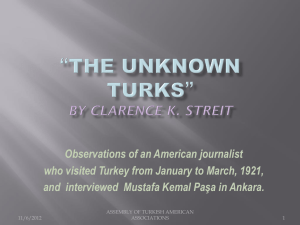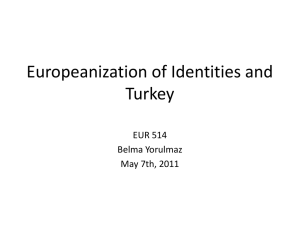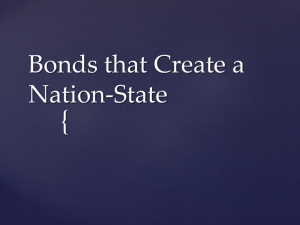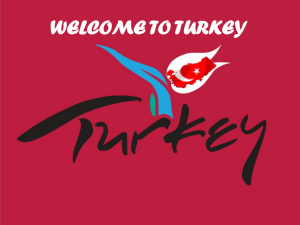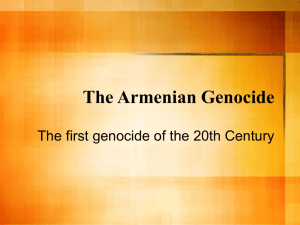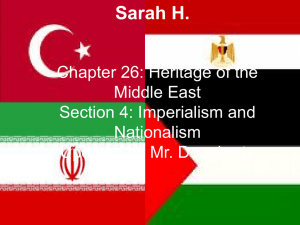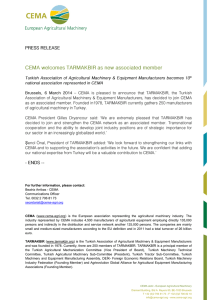From Caliphate to Secular Republic
advertisement
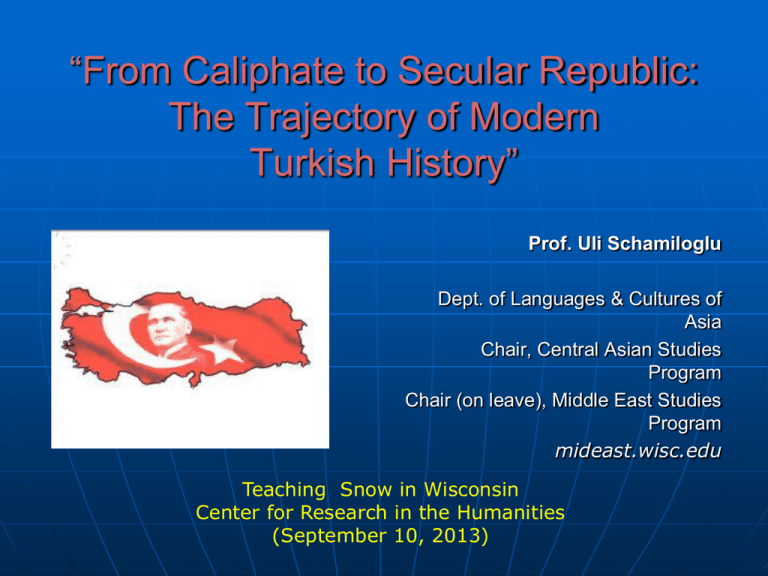
“From Caliphate to Secular Republic: The Trajectory of Modern Turkish History” Prof. Uli Schamiloglu Dept. of Languages & Cultures of Asia Chair, Central Asian Studies Program Chair (on leave), Middle East Studies Program mideast.wisc.edu Teaching Snow in Wisconsin Center for Research in the Humanities (September 10, 2013) Republic of Turkey (A secular nation-state) Population: 80,694,485 (July 2013 est.) Ottoman Empire (1299-1923) 1299, Osman Gazi: origins as leader of a beylik Orhan captures Bursa (1324) 1389, Battle of Kosovo 1402, Battle of Ankara (loss to Timur) Image: Battle of Nikopolis (1396) Ottoman Empire (2) 1453, Sultan Fatih Mehmet conquers Constantinople (today: Istanbul) Ottoman Empire (3) Classical Period Islamic state Sultan was from Ottoman dynasty Also Caliph (1517-1924) Millet system Devshirme system Expansion to gates of Vienna (1683), throughout Middle East, etc. Ottoman Empire at its Peak Ottoman Empire in the 19th Century Tanzimat period (1839–1876) Ottoman Empire was shrinking New currency, post office, etc. Educational reforms (including new schools) Efforts to eliminate corruption European-style courts Elimination of Islamic poll tax on non-Muslims (cizye) Granting of “Ottoman” citizenship to all inhabitants of the Empire without regard for ethnicity or religion Military reorganization with universal conscription New ideology of “Ottomanism” Ottoman Empire in the 19th-20th Centuries Ottoman Empire in the 19th Century (2) Abdülhamit II (r. 1876-1909) 1876-1878, First Constitutional Era (closer to a constitutional monarchy without parties) Promoted “Islamism” rather than “Ottomanism” 1908, Young Turk Revolution leads to Second Constitutional Era 1909, Military force the Sultan to abdicate (but many Christians die in “countercoup”) Young Turks Rise of Turkish nationalism “Young Turks” as a secularist, nationalist reform party opposed to absolute monarchy Various groups merge as Committee of Union and Progress (CUP) 1913, CUP seizes power in a coup Armenian protests beginning in 1890s; massacres known as “Armenian Genocide” begin April 1915 (but killings on both sides) At end of World War I, rump Ottoman Empire is occupied (Constantinople, Smyrna/Izmir) Middle East in 1914 Sykes-Picot Agreement (1916) Turkish War of Independence (May 19, 1919 – July 24, 1923) Republic of Turkey (established October 29, 1923) Looking to the West: Atatürk’s Reforms Turkish Grand National Assembly (1920) Constitution (1921) rejects Sultan as source of legitimacy Abolition of sultanate (1922) New republic declared (1923) Capital moved to Ankara (1923) New Constitution (1924) Abolition of caliphate & office of sheyh ül-islam (1924) & new Presidency of Religious Affairs (today the Ministry of Religious Affairs) International (Gregorian) calendar (1925) Millet system abolished Looking to the West: Atatürk’s Reforms (2) Principle of “laicism” (1937), individual faith is guaranteed, but not religious communities Regulation of clothing (1923-) and “Hat Law” (1925) banning fez & turban for men, “Law on Prohibited Garments” (1934) also banned veil Use of Turkish as liturgical language (1932-1950) Banning of Sufi orders and lodges (1925) Introduction of civil code based on Swiss code & penal code based on Italian code (1926) Polygamy banned, gender equality in inheritance New system of state-supervised coed education New Western-style universities Looking to the West: Atatürk’s Reforms (3) New Latin alphabet goes into effect (1/1/1929) “Language reform” vs. Arabic & Persian words Drive for literacy (1928) Drive to Westernize language & education “Law on Family Names” (1934) New national ideology of “Turkism” (yet keeping Turkic peoples of USSR at arm’s length…) National monopolies (tobacco, alcohol, etc.) National infrastructure (railroad, etc.) New national organizations (Turkish Historical Society, Turkish Linguistic Society, etc.) to promote new national identity & ideology Turkish Nationalism Mustafa Kemal Atatürk (1881-1938) www.ataturk.com Iconic figure of modern Turkish nationalism (his ideology known as “Kemalism”) Contradictions in Turkish National Identity Ethnic Diversity in Turkey (ca. 1910) Ethnic Diversity in Turkey: Kurds (1) Ethnic Diversity in Turkey: Kurds (2) Who is a Turk? Are you only an ethnic Turk? Cherkes (Circassians) and other Caucasian minorities; Laz Arabs Armenians Kurds Kurdish was banned, now it appears on signs & TRT Shesh Right to bilingual education? Controvery over “Armenian Genocide” Snow: “Armenian Massacre” Issues in Turkish Religious Identity There is a separation of the religious sphere and the public sphere The mosques are funded/controlled by the state Religious officials are employees of the state Officials at mosques read sermons produced by the Ministry of Religious Affairs Faculties of Divinity are located in state-run universities Sufi orders are still banned There is a split between Sunnis and Alevis How accepted are non-Muslim citizens in Turkey? Sunni & Alevi Regions in Turkey Russian Conquest in the Caucasus “The 1828 Russian siege of Kars” (by January Suchodolski). Treaty of Kars (1921) Kars, Turkey Kars Citadel Armenian civilians fleeing Kars after its capture by Kâzım Karabekir's forces. Kars, Turkey Turkey in the 20th Century A successful (?) secular multi-party (1946- ) democracy in the Middle East NATO ally, with 2nd largest military (Cold War) Strong (crude?) national project GAP project for developing SE Anatolia, etc. Tremendous investment in national infrastructure (subways, high speed rail, airports, factories, etc.) A History of Military Coups [1909, Forced abdication of Abdülhamit II] [1913, CUP coup] Military coup in 1960 [Adnan Menderes] Military coup in 1971 [Süleyman Demirel] Military coup in 1980 [Kenan Evren, new constitution institutionalizing role of the military] Post-modern coup d'état in 1997 (and 2007?) Military now under civilian control Current wave of trials of 1980 coup figures & “conspirators” Efforts to write a new, “demilitarized” constitution Turks in Germany Gastarbeiters ‘guest workers’ Economic opportunities for workers [mostly from Anatolia!] in Germany (1960s- ) Leftist activity (1970s) PKK/Kurdish Workers Party (1970s- ) Several generations, some assimilated (politicians), some unassimilated (don’t speak German!) Koranschulen, etc. Today leads to conflicts in Germany Major Issues in the 20th Century Armenian “Genocide” (1915) [Nancy Pelosi, Orhan Pamuk, Article 301, Hrant Dink] Turkish national project Cold War & NATO membership Invasion of Cyprus (1974) Reclaiming the Turkic World (1991- ) Moves for acceptance by European Union Relations with neighbors (USSR, Greece, Syria, `Iraq, Armenia/Azerbaycan, etc.) Preserving the secular, Kemalist state (coups, etc.) Strong military & police apparatus, clearly latter requires retraining Rise of the Adalet ve Kalkinma Partisi (AKP) The current Prime Minister is the former mayor of İstanbul, Recep Tayyip Erdoğan His conservative AKP won an absolute majority of parliamentary seats in the 2002 general elections, organized in the aftermath of the economic crisis of 2001, with 34% of the suffrage. In the 2007 general elections, the AKP received 46.6% of the votes and could defend its majority in parliament. Turkish President Abdullah Gul & his wife Turkey at the Edge (1) Does the rise of AKP (and the collapse of the opposition) spell the end of the secular Turkish Republic? AKP is a strong proponent of the EU Tensions between AKP and the Turkish military, including recently instituting civilian control over the military. BUT concern over show trials of military leadership. High number of jailed journalists. The notion of the “deep state” Clean government or mafias? Does AKP have a mandate to rewrite the Turkish Constitution? The debate over lifting the headscarf ban in public institutions The struggle to revise Article 301 (insulting the Turkish state) The past US role in `Iraq and the plunge in popularity of the US in Turkey The Turkish role in `Iraq and the struggle against the PKK Turkey at the Edge (2) Turkey was successful seeking new alliances in the region, but has suffered setbacks recently Difficulties in relations with US (including over possible recognition of Armenian Genocide by US Congress) National protests over AKP’s supposed attempts to Islamize the state, but EU protest over “judicial coup attempt” to close AKP “Mavi Marmara” incident disrupts close ties with Israel AKP support for Egypt’s ex-President Morsi and a role for the Muslim Brotherhood The protests over Gezi Park has tarnished Turkey’s reputation “Kurdish Opening” is hitting a bump At present Turkey is an advocate of punishing Syria for use of chemical weapons Conclusions Nearing the end of its 9th decade as a modern secular republic with a titular Turkish nation, Turkey has had to become more mature as a state. There is a nostalgia for the Ottoman past & its civilization. There was (at least for a while) a sense that Turkey should enjoy a position of leadership in the Middle East, as the Ottoman Empire once did. There is also a sense of leadership in the broader Turkicspeaking world. There is a sense that Islam should be represented more prominently in the public sphere (though not everybody thinks so!). There is a fear of a “creeping Islamism” in Turkey on the part of Kemalists. There is a sense that non-Turkish speaking citizens of Turkey need to have concessions made to them, but what? (Bilingual education?) There is a lingering popular conspiracy theory that the “Greater Middle East Project” wants to reorder the Middle East, including breaking up Turkey… Uli Schamiloglu uschamil@wisc.edu Professor Dept. of Languages and Cultures of Asia Chair, Central Asian Studies Program Chair (on leave), Middle East Studies Program mideast.wisc.edu

